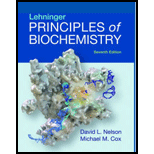
Concept explainers
To determine: The protein that has higher affinity for ligand X. Whether it is protein A or B.
Introduction:
Proteins are the
Explanation of Solution
Dissociation constant (Kd) explains the binding of a ligand to its particular receptor. In molar concentration, dissociation constant matches with the concentration of ligands. The smaller the Kd, more strongly the ligand is bound to its receptors and high
To determine: The conversion of Kd into Ka (association constant) for protein A and protein B.
Introduction:
Kd denotes the dissociation constant, that describes how a ligand bound to its receptor. Small Kd indicates higher affinity, while high Kd indicates less affinity. Ka is just the inverse of the Kd. It is also called association or binding constant. They are involved in unbinding of the ligand and receptors.
Explanation of Solution
Dissociation constant tells the binding of a ligand to its receptor. Whereas association constant tells the unbinding of a ligand and receptors. So, they are just opposite to each other. As Ka is the inverse of Kd, the protein A has Ka of 106M-1 and protein B has Ka of 109M-1.
Want to see more full solutions like this?
Chapter 5 Solutions
Lehninger Principles of Biochemistry
 BiochemistryBiochemistryISBN:9781319114671Author:Lubert Stryer, Jeremy M. Berg, John L. Tymoczko, Gregory J. Gatto Jr.Publisher:W. H. Freeman
BiochemistryBiochemistryISBN:9781319114671Author:Lubert Stryer, Jeremy M. Berg, John L. Tymoczko, Gregory J. Gatto Jr.Publisher:W. H. Freeman Lehninger Principles of BiochemistryBiochemistryISBN:9781464126116Author:David L. Nelson, Michael M. CoxPublisher:W. H. Freeman
Lehninger Principles of BiochemistryBiochemistryISBN:9781464126116Author:David L. Nelson, Michael M. CoxPublisher:W. H. Freeman Fundamentals of Biochemistry: Life at the Molecul...BiochemistryISBN:9781118918401Author:Donald Voet, Judith G. Voet, Charlotte W. PrattPublisher:WILEY
Fundamentals of Biochemistry: Life at the Molecul...BiochemistryISBN:9781118918401Author:Donald Voet, Judith G. Voet, Charlotte W. PrattPublisher:WILEY BiochemistryBiochemistryISBN:9781305961135Author:Mary K. Campbell, Shawn O. Farrell, Owen M. McDougalPublisher:Cengage Learning
BiochemistryBiochemistryISBN:9781305961135Author:Mary K. Campbell, Shawn O. Farrell, Owen M. McDougalPublisher:Cengage Learning BiochemistryBiochemistryISBN:9781305577206Author:Reginald H. Garrett, Charles M. GrishamPublisher:Cengage Learning
BiochemistryBiochemistryISBN:9781305577206Author:Reginald H. Garrett, Charles M. GrishamPublisher:Cengage Learning Fundamentals of General, Organic, and Biological ...BiochemistryISBN:9780134015187Author:John E. McMurry, David S. Ballantine, Carl A. Hoeger, Virginia E. PetersonPublisher:PEARSON
Fundamentals of General, Organic, and Biological ...BiochemistryISBN:9780134015187Author:John E. McMurry, David S. Ballantine, Carl A. Hoeger, Virginia E. PetersonPublisher:PEARSON





